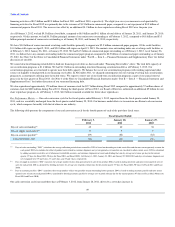Dell 2011 Annual Report Download - page 58
Download and view the complete annual report
Please find page 58 of the 2011 Dell annual report below. You can navigate through the pages in the report by either clicking on the pages listed below, or by using the keyword search tool below to find specific information within the annual report.
Table of Contents
ITEM 7A — QUANTITATIVE AND QUALITATIVE DISCLOSURES ABOUT MARKET RISK
We are exposed to a variety of risks, including foreign currency exchange rate fluctuations and changes in the market value of our investments. In the normal
course of business, we employ established policies and procedures to manage these risks.
Foreign Currency Risk
During Fiscal 2012, the principal foreign currencies in which we transacted business were the Euro, Chinese Renminbi, Japanese Yen, British Pound,
Canadian Dollar, and Australian Dollar. Our objective in managing our exposures to foreign currency exchange rate fluctuations is to reduce the impact of
adverse fluctuations associated with foreign currency exchange rate changes on our earnings and cash flows. Accordingly, we utilize foreign currency option
contracts and forward contracts to hedge our exposure on forecasted transactions and firm commitments for certain currencies. During Fiscal 2012, we hedged
our exposures on more than 20 currencies. We monitor our foreign currency exchange exposures to ensure the overall effectiveness of our foreign currency
hedge positions. However, there can be no assurance that our foreign currency hedging activities will continue to substantially offset the impact of
fluctuations in currency exchange rates on our results of operations and financial position in the future.
Based on our foreign currency cash flow hedge instruments outstanding at February 3, 2012, and January 28, 2011, we estimate a maximum potential one-day
loss in fair value of approximately $57 million and $65 million, respectively, using a Value-at-Risk (“VAR”) model. By using market implied rates and
incorporating volatility and correlation among the currencies of a portfolio, the VAR model simulates 3,000 randomly generated market prices and calculates
the difference between the fifth percentile and the average as the Value-at-Risk. The VAR model is a risk estimation tool and is not intended to represent
actual losses in fair value that will be incurred. Additionally, as we utilize foreign currency instruments for hedging forecasted and firmly committed
transactions, a loss in fair value for those instruments is generally offset by increases in the value of the underlying exposure.
Interest Rate Risk
We also are exposed to interest rate risk related to our debt and investment portfolios and financing receivables. We mitigate the risk related to our structured
financing debt through the use of interest rate swaps to hedge the variability in cash flows related to the interest rate payments on such debt. See Note 6 of the
Notes to Consolidated Financial Statements included in “Part II — Item 8 — Financial Statements and Supplementary Data” for more information on our
interest rate swaps.
We mitigate the risks related to our investment portfolio by investing primarily in high credit quality securities, limiting the amount that can be invested in
any single issuer, and investing in short -to- intermediate-term investments. Based on our investment portfolio and interest rates as of February 3, 2012, a 100
basis point increase or decrease in interest rates would result in a decrease or increase of approximately $61 million in the fair value of our investment
portfolio. As of January 28, 2011, a 100 basis point increase or decrease in interest rates would have resulted in a decrease or increase of approximately $4
million in the fair value of our investment portfolio. The overall increase in our interest rate sensitivity from January 28, 2011, to February 3, 2012, was due to
a shift to longer-duration investments.
56
























